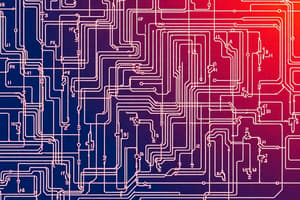Podcast
Questions and Answers
电路的定义是什么?
电路的定义是什么?
- 电流流动的开放路径。
- 电压的升高路径。
- 电流流动的闭合路径。 (correct)
- 只有电池的路径。
在串联电路中,电流的特征是什么?
在串联电路中,电流的特征是什么?
- 电流在每个组件中是相同的。 (correct)
- 电流在每个组件中逐渐消失。
- 电流在所有组件之间均匀分布。
- 只有主电源提供电流。
按照欧姆定律,电压和电流的关系是什么?
按照欧姆定律,电压和电流的关系是什么?
- V = I / R
- V = R - I
- V = I + R
- V = I × R (correct)
基尔霍夫的电流定律(KCL)的主要内容是什么?
基尔霍夫的电流定律(KCL)的主要内容是什么?
在并联电路中,电压的特征是什么?
在并联电路中,电压的特征是什么?
下列关于电阻的描述,哪个是正确的?
下列关于电阻的描述,哪个是正确的?
电路中的功率如何计算?
电路中的功率如何计算?
电路分析方法中,哪种方法是使用基尔霍夫的电压定律?
电路分析方法中,哪种方法是使用基尔霍夫的电压定律?
Flashcards
什么是电路?
什么是电路?
电路中电流流动的闭合路径。包含能源,元件和闭合回路。
什么是电源?
什么是电源?
驱动电路中电流流动的能量来源,例如电池或发电机。
什么是电流?
什么是电流?
电荷(电子)在导体中的流动。
什么是电压?
什么是电压?
Signup and view all the flashcards
什么是电阻?
什么是电阻?
Signup and view all the flashcards
什么是串联电路?
什么是串联电路?
Signup and view all the flashcards
什么是并联电路?
什么是并联电路?
Signup and view all the flashcards
欧姆定律是什么?
欧姆定律是什么?
Signup and view all the flashcards
Study Notes
Basic Definitions
- An electric circuit is a closed path along which an electric current flows.
- A circuit must contain a source of electrical energy (e.g., battery, generator) to provide the driving force.
- Components like resistors, capacitors, inductors, and diodes are connected to control the flow of current.
- Closed-loop path: The circuit must form a complete loop for current to flow continuously.
- Electrical current is the flow of electric charge (electrons) through a conductor.
- Voltage is the electrical potential difference between two points in a circuit. It pushes the current.
- Resistance is the opposition to the flow of current in a circuit. Measured in ohms (Ω).
Types of Circuits
- Series Circuit: Components are connected end-to-end in a single path.
- Total resistance: The sum of individual resistances.
- Current: The same current flows through all components.
- Voltage: Voltage divides across each component proportionally to its resistance.
- Parallel Circuit: Components are connected across two common points.
- Total resistance: Less than the smallest individual resistance.
- Current: Current divides among branches, with the total current being the sum of the currents in each branch.
- Voltage: The voltage across each component is the same.
Ohm's Law
- Ohm's law relates voltage, current, and resistance in a simple circuit.
- V = I × R, where:
- V = voltage (volts)
- I = current (amperes)
- R = resistance (ohms)
Kirchhoff's Laws
- Kirchhoff's current law (KCL): The total current entering a junction is equal to the total current leaving it.
- Kirchhoff's voltage law (KVL): The algebraic sum of the voltages around any closed loop in a circuit is zero.
Power in Circuits
- Power is the rate at which energy is dissipated in a circuit.
- P = I × V, where:
- P = power (watts)
- I = current (amperes)
- V = voltage (volts)
Circuit Analysis Methods
- Loop analysis: Using Kirchhoff's voltage law to solve for the currents flowing in each branch of the circuit.
- Node analysis: Using Kirchhoff's current law to solve for the voltages at various points in the circuit.
Circuit Elements
- Resistor: A component that opposes the flow of current.
- Capacitor: A component that stores electrical energy in an electric field.
- Inductor: A component that stores energy in a magnetic field.
- Switch: A component that opens or closes a circuit to control the flow of current.
- Source: Provides electrical energy (e.g., battery, generator, transformer).
- Diode: Component that allows current to flow in one direction only.
AC Circuits
- AC circuits involve alternating current (current that changes direction periodically).
- AC sources use sinusoidal waveforms to generate current.
- Key concepts in AC circuits are frequency, impedance, reactance (capacitive and inductive).
- AC circuit analysis differs from DC, needing concepts like phase, complex numbers, and impedance diagrams.
Safety Considerations
- Electrical circuits require proper safety measures to prevent electric shock and fire hazards.
- Isolation, grounding, circuit breakers, and fuses are critical for safety.
Studying That Suits You
Use AI to generate personalized quizzes and flashcards to suit your learning preferences.




